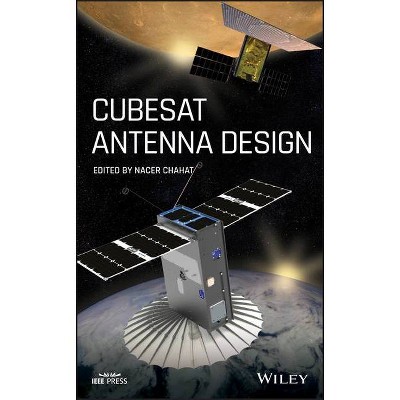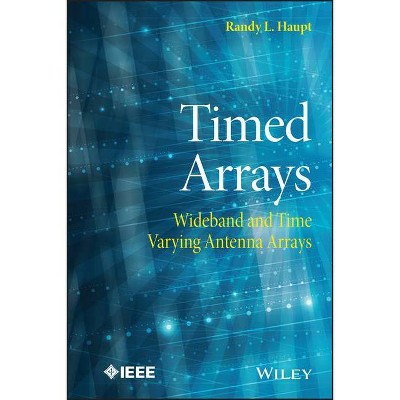Cubesat Antenna Design - (IEEE Press) by Nacer Chahat (Hardcover)

Similar Products
Products of same category from the store
AllProduct info
<p/><br></br><p><b> About the Book </b></p></br></br>"This book surveys a variety of antenna designs used for CubeSat communication and radar by the Jet Propulsion Laboratory (JPL). The first chapter presents a brief introduction of CubeSats. The second chapter illustrates the telecommunication subsystem of Mars Cube One (MarCO) mission, with an emphasis on the antenna development. The third chapter describes the enabling technology of Radar in a CubeSat (RainCube): the 0.5m deployable mesh reflector. Chapter 4 presents the electrical and mechanical design of the largest reflectarray compatible with a 6U-class CubeSat: OMERA (one meter reflectarray antenna). Chapter 5 explains the development of a one-meter mesh reflector for telecommunication at X- and Ka-band for deep space missions. In Chapter 6, an inflatable antenna operating at X-band is shown from an electrical and mechanical point of view with all the challenges associated with operation in space. In Chapter 7, depicts how a novel patch array mainly made of metal is used on a CubeSat. Finally, Chapter 8 describes the design of multiple metasurface antennas"--<p/><br></br><p><b> Book Synopsis </b></p></br></br><p><b>Presents an overview of CubeSat antennas designed at the Jet Propulsion Laboratory (JPL)</b></p> <p>CubeSats--nanosatellites built to standard dimensions of 10cm x 10 cm x cm--are making space-based Earth science observation and interplanetary space science affordable, accessible, and rapidly deployable for institutions such as universities and smaller space agencies around the world. <i>CubeSat Antenna Design</i> is an up-to-date overview of CubeSat antennas designed at NASA's Jet Propulsion Laboratory (JPL), covering the systems engineering knowledge required to design these antennas from a radio frequency and mechanical perspective.</p> <p>This authoritative volume features contributions by leading experts in the field, providing insights on mission-critical design requirements for state-of-the-art CubeSat antennas and discussing their development, capabilities, and applications. The text begins with a brief introduction to CubeSats, followed by a detailed survey of low-gain, medium-gain, and high-gain antennas. Subsequent chapters cover topics including the telecommunication subsystem of Mars Cube One (MarCO), the enabling technology of Radar in a CubeSat (RainCube), the development of a one-meter mesh reflector for telecommunication at X- and Ka-band for deep space missions, and the design of multiple metasurface antennas. Written to help antenna engineers to enable new CubeSate NASA missions, this volume: </p> <ul> <li>Describes the selection of high-gain CubeSat antennas to address specific mission requirements and constraints for instruments or telecommunication</li> <li>Helps readers learn how to develop antennas for future CubeSat missions</li> <li>Provides key information on the effect of space environment on antennas to inform design steps</li> <li>Covers patch and patch array antennas, deployable reflectarray antennas, deployable mesh reflector, inflatable antennas, and metasurface antennas</li> </ul> <p><i>CubeSat Antenna Design </i>is an important resource for antenna/microwave engineers, aerospace systems engineers, and advanced graduate and postdoctoral students wanting to learn how to design and fabricate their own antennas to address clear mission requirements.</p><p/><br></br><p><b> From the Back Cover </b></p></br></br><p><b>Presents an overview of CubeSat antennas designed at the Jet Propulsion Laboratory (JPL)</b> <p>CubeSats--nanosatellites built to standard dimensions of 10cm x 10 cm x 10cm--are making space-based Earth science observation and interplanetary space science affordable, accessible, and rapidly deployable for institutions such as universities and smaller space agencies around the world. <i>CubeSat Antenna Design</i> is an up-to-date overview of CubeSat antennas designed at NASA's Jet Propulsion Laboratory (JPL), covering the systems engineering knowledge required to design these antennas from a radio frequency and mechanical perspective. <p>This authoritative volume features contributions by leading experts in the field, providing insights on mission-critical design requirements for state-of-the-art CubeSat antennas and discussing their development, capabilities, and applications. The text begins with a brief introduction to CubeSats, followed by a detailed survey of low-gain, medium-gain, and high-gain antennas. Subsequent chapters cover topics including the telecommunication subsystem of Mars Cube One (MarCO), the enabling technology of Radar in a CubeSat (RainCube), the development of a one-meter mesh reflector for telecommunication at X- and Ka-band for deep space missions, and the design of multiple metasurface antennas. Written to help antenna engineers to enable new CubeSat NASA missions, this volume: <ul> <li>Describes the selection of high-gain CubeSat antennas to address specific mission requirements and constraints for instruments or telecommunication</li> <li>Helps readers learn how to develop antennas for future CubeSat missions</li> <li>Provides key information on the effect of space environment on antennas to inform design steps</li> <li>Covers patch and patch array antennas, deployable reflectarray antennas, deployable mesh reflector, inflatable antennas, and metasurface antennas</li> </ul> <p><i>CubeSat Antenna Design</i> is an important resource for antenna/microwave engineers, aerospace systems engineers, and advanced graduate and postdoctoral students wanting to learn how to design and fabricate their own antennas to address clear mission requirements.<p/><br></br><p><b> About the Author </b></p></br></br><p><b>NACER CHAHAT</b>, PHD, is a Senior Antenna/Microwave Engineer with the National Aeronautics and Space Administration (NASA) Jet Propulsion Laboratory (JPL), California Institute of Technology, Pasadena, CA. He developed critical antenna technologies that have enabled new types of NASA missions, delivered antennas for Mars Cube One, the first deep space CubeSat, and delivered the deployable mesh reflector that has enabled Raincube, the first active radar in a CubeSat.</p>
Price History
Price Archive shows prices from various stores, lets you see history and find the cheapest. There is no actual sale on the website. For all support, inquiry and suggestion messages communication@pricearchive.us




















